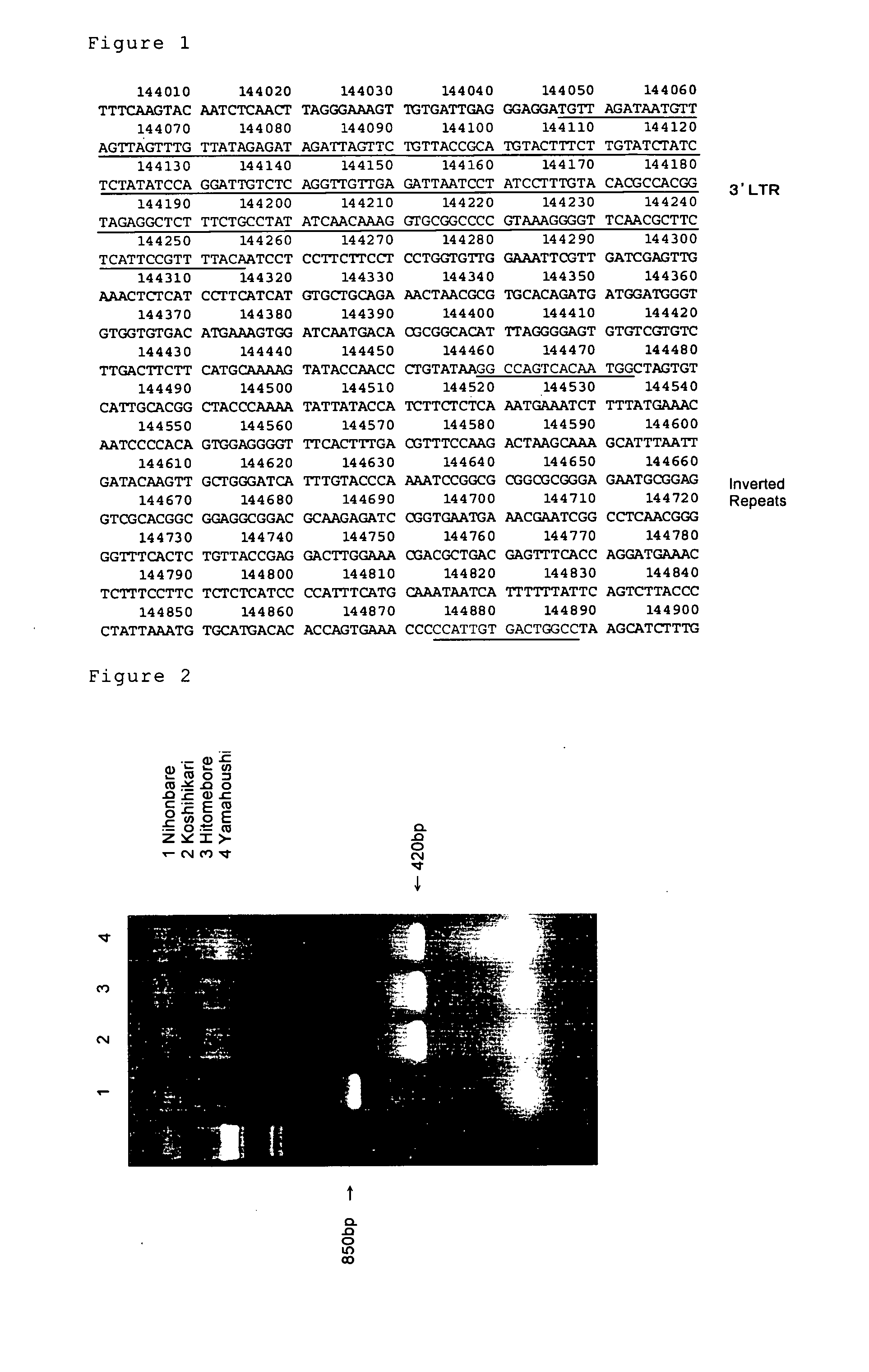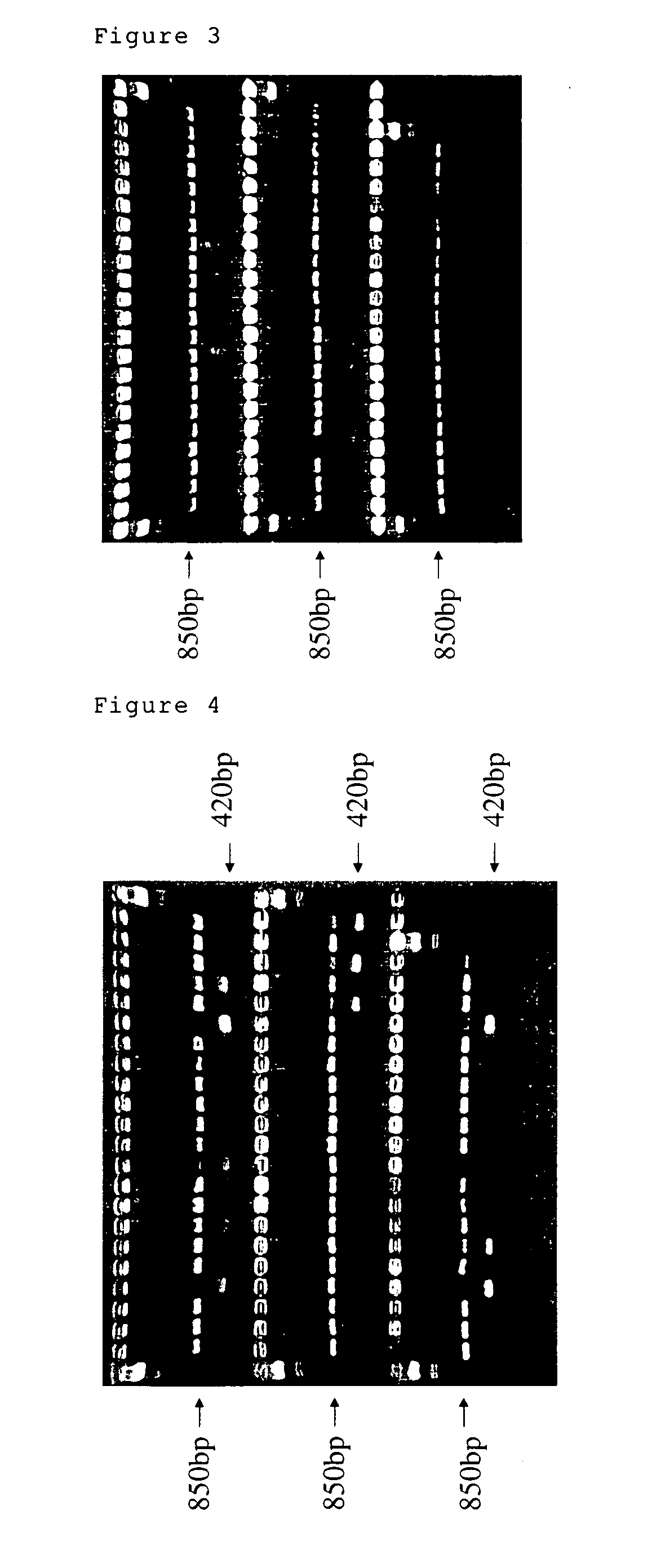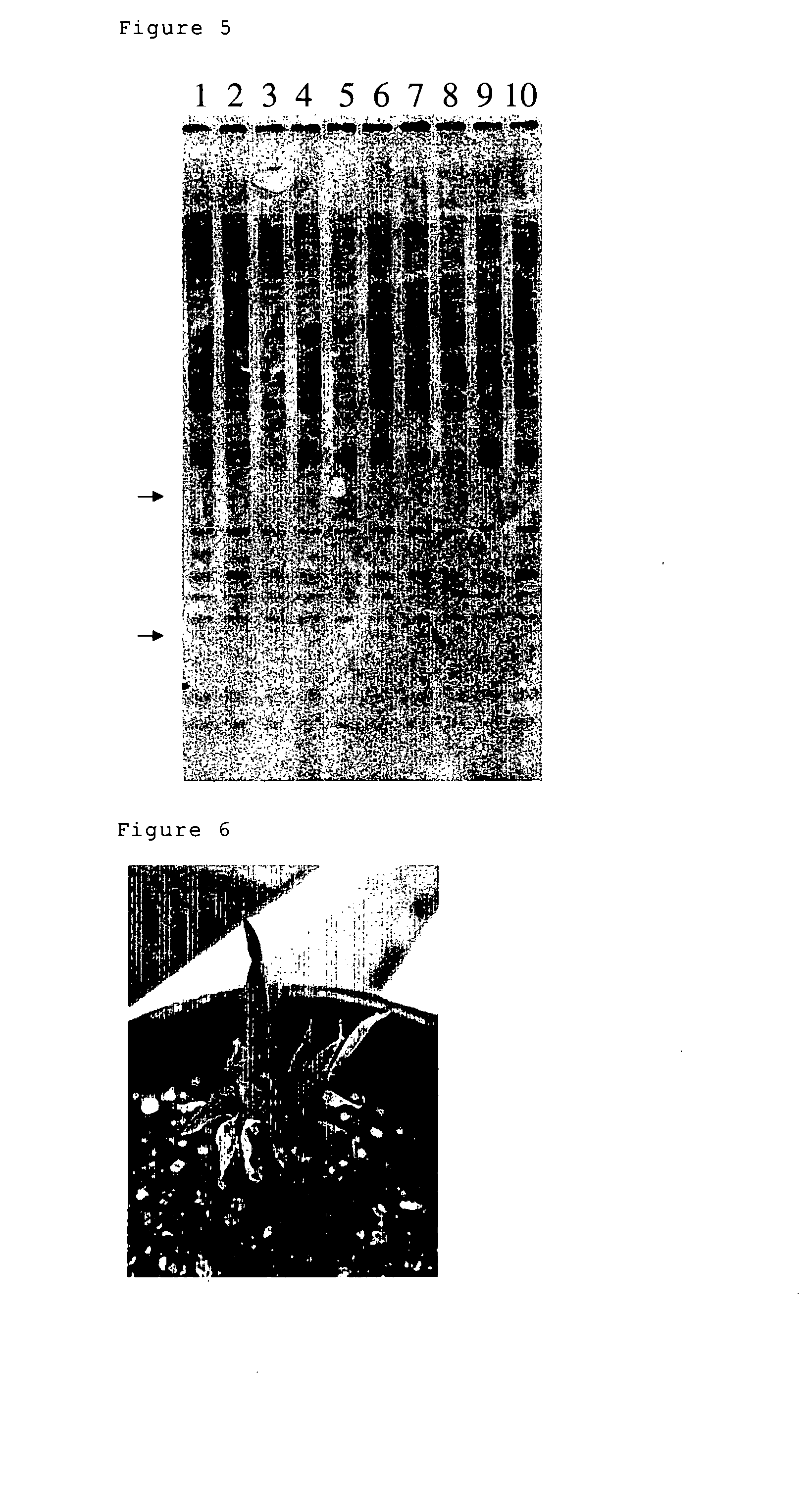Rice transposon genes
a transposon gene and rice technology, applied in the field of non-autonomous transposon gene, autonomous transposon gene and transposase gene, can solve the problems of insufficient elucidation and analysis of spontaneous mutant rice rice that has not served to find active transposons, and achieves easy and artificial transposition, easy isolation, and easy and efficient transposition.
- Summary
- Abstract
- Description
- Claims
- Application Information
AI Technical Summary
Benefits of technology
Problems solved by technology
Method used
Image
Examples
example 2
[0065] DNA was isolated from leaves of 4 cultivars of rice, Nihonbare, Koshihikari, Hitomebore and Yamahoushi. To amplify the DNA region containing the transposon DNA (accession number AP002843) by PCR, we used the oligonucleotides comprising the sequences of Sequence Number 8 and 9 as PCR primers. Each reaction mixture (100 μl) contained 200 ng of DNA, 2.5 units of AmpliTaq Gold (ABI Co.), 10 μl of GeneAmp10×PCR buffer (contains 15 mM MgCl2), 10 μl of Gene Amp Mixture (2 mM each dNTP) and 200 pmol of primers. Each cycle of the polymerase reaction consisted of a denaturation step at 96° C. for 30 sec, an annealing step at 55° C. for 1 min and an extension step at 72° C. for 1 min. This cycle was repeated 35 times. After the reaction, DNA was separated on 2% L03 agarose (Takara Co.) FIG. 2 shows the result of the agarose gel electrophoresis. The DNA band of approximately 850 bp was found only for Nihonbare (lane 2). The DNA band of approximately 850 bp indicates the DNA fragment, inc...
example 3
[0068] Spikes of Nihonbare were harvested at pre-emergence, kept in cold treatment for 10 days at 10° C., sterilized in 1% sodium hypochlorite solution for 1 min and washed with sterilized water. Then, anthers were picked out from the floret, seeded in a 35×10 mm Petri dish (CORNING Co.) containing 3 ml of liquid medium at the rate of 50 anthers per dish and subjected to induction culture under light for 24 h at 30° C. We used a liquid medium consisting of 4 g of CHU (N6) Basal Salt Mixture (Sigma Co.), 1 ml of MS vitamin solution (Sigma Co.), 2mg of 2,4-dichloro-phenoxyacetic acid (Sigma Co.), 30 g of sucrose (Wako) in 1 L of medium. After 3˜4 weeks of inductive culture, the calli derived from induced anthers were transplanted to a 90×20 mm of Petri dish (Iwaki Co.) containing 20˜30 ml of medium and subjected to growth culture under light for 24 h at 30° C. We used a solid medium consisting of 4 g of CHU (N6) Basal Salt Mixture (Sigma Co.), 1 ml of MS vitamin solution (Sigma Co.), ...
example 4
[0072] Spikes of Nihonbare were harvested at pre-emergence, kept in cold treatment for 10 days at 10° C., sterilized in 1% sodium hypochlorite solution for 1 min and washed with sterilized water. Then, anthers were picked out from the floret, seeded in a 35×10 mm Petri dish (CORNING Co.) containing 3 ml of liquid medium at the rate of 50 anthers per dish and subjected to induction culture under light for 24 h at 30° C. We used a liquid medium consisting of 4 g of CHU (N6) Basal Salt Mixture (Sigma Co.), 1 ml of MS vitamin solution (Sigma Co.), 2mg of 2,4-dichloro-phenoxyacetic acid (Sigma Co.), 30 g of sucrose (Wako) in 1 L of medium. After 3˜4 weeks of inductive culture, the calli derived from induced anthers were transplanted to a 90×20 mm of Petri dish (Iwaki Co.) containing 20˜30 ml of medium and subjected to growth culture under light for 24 h at 30° C. We used a solid medium consisting of 4 g of CHU (N6) Basal Salt Mixture (Sigma Co.), 1 ml of MS vitamin solution (Sigma Co.), ...
PUM
| Property | Measurement | Unit |
|---|---|---|
| length | aaaaa | aaaaa |
| width | aaaaa | aaaaa |
| mutation frequency | aaaaa | aaaaa |
Abstract
Description
Claims
Application Information
 Login to View More
Login to View More - R&D
- Intellectual Property
- Life Sciences
- Materials
- Tech Scout
- Unparalleled Data Quality
- Higher Quality Content
- 60% Fewer Hallucinations
Browse by: Latest US Patents, China's latest patents, Technical Efficacy Thesaurus, Application Domain, Technology Topic, Popular Technical Reports.
© 2025 PatSnap. All rights reserved.Legal|Privacy policy|Modern Slavery Act Transparency Statement|Sitemap|About US| Contact US: help@patsnap.com



